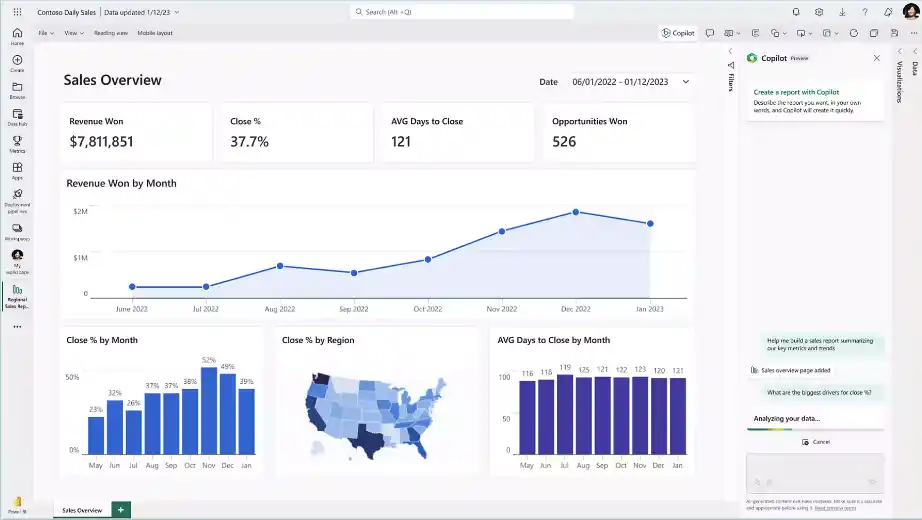What to Know About Microsoft Fabric if you Already Have Power BI
For all of you out there wondering what the freshly launched Microsoft Fabric means if you’re already using Power BI, stay put.
2 min read
Dave Rowe Jul 26, 2024 10:21:20 AM

As Microsoft rolls out its comprehensive analytics platform, Microsoft Fabric, existing Power BI users face a pivotal moment of transition. This integration promises not just a new set of tools but a significant enhancement in how data is managed, analyzed, and utilized across organizations. In this blog, we explore the key benefits of moving to Microsoft Fabric for Power BI users and why this transition could be a major win for businesses.
One of the most compelling reasons for Power BI users to transition to Microsoft Fabric is the unification of data services under a single platform. Microsoft Fabric seamlessly integrates data warehousing, data engineering, data science, and real-time analytics with business intelligence capabilities. This integration enables a more cohesive data management strategy, reducing the complexity of juggling multiple tools and platforms (element61).
For Power BI users, this means all analytics work, from data ingestion to visualization, can be managed within one environment. The unified ecosystem facilitates smoother workflows, better data governance, and streamlined operations, helping organizations to operate more efficiently (Microsoft Fabric Community) (MS Learn).
Microsoft Fabric introduces a new licensing and pricing model that offers greater flexibility compared to traditional Power BI Premium capacities. The "Pay-as-you-go" model allows organizations to scale their compute and storage resources according to their specific needs. This means you can adjust capacity based on real-time requirements, potentially leading to cost savings during off-peak periods (element61) (Microsoft Fabric Community).
This scalability is particularly beneficial for organizations with fluctuating data workloads. For instance, if you have resource-intensive tasks like complex data transformations or large-scale data analysis, you can temporarily increase your capacity and then scale it down once the tasks are completed. This flexibility ensures that you only pay for what you use, optimizing budget allocation (Microsoft Fabric Community).
Microsoft Fabric brings advanced analytics and AI capabilities into the hands of Power BI users. With features like Direct Lake, users can perform real-time queries on massive datasets without moving data, offering unprecedented speed and efficiency in data analysis. This feature is particularly useful for scenarios that require up-to-the-minute insights, such as monitoring real-time sales or operational metrics (MS Learn) (MS Learn).
Furthermore, the integration of AI capabilities, such as machine learning and predictive analytics, empowers users to go beyond traditional data analysis. These tools allow organizations to uncover deeper insights and trends, enabling data-driven decision-making at a strategic level (MS Learn).
With the transition to Microsoft Fabric, Power BI users gain enhanced collaboration features. Fabric's integrated environment allows teams to work together on data projects more effectively. The platform supports version control, workflow management, and role-based access, ensuring that the right people have access to the right data at the right time (MS Learn).
Moreover, Fabric's unified data governance framework helps organizations maintain control over their data assets. This includes features for data lineage, auditing, and compliance, making it easier to manage data policies and ensure data integrity across the organization (MS Learn).
By transitioning to Microsoft Fabric, Power BI users are positioning themselves for the future. The platform is designed to be extensible and adaptable, accommodating new technologies and data paradigms as they emerge. This future-proofing aspect ensures that your organization remains at the forefront of data innovation, leveraging the latest tools and technologies to stay competitive (MS Learn).
The move to Microsoft Fabric offers numerous benefits for existing Power BI users, from enhanced scalability and flexibility to advanced analytics and improved collaboration. As organizations increasingly rely on data to drive decisions, the unified, powerful capabilities of Microsoft Fabric provide a robust foundation for future growth and innovation. If you need help navigating this change please contact us today!

For all of you out there wondering what the freshly launched Microsoft Fabric means if you’re already using Power BI, stay put.

Enhance the full potential of your business with Microsoft Fabric, a platform designed to seamlessly integrate data and elevate your operations to...

It’s more important than ever today for businesses to make data-driven decisions. But while 90% of organizations indicate that data is increasingly...